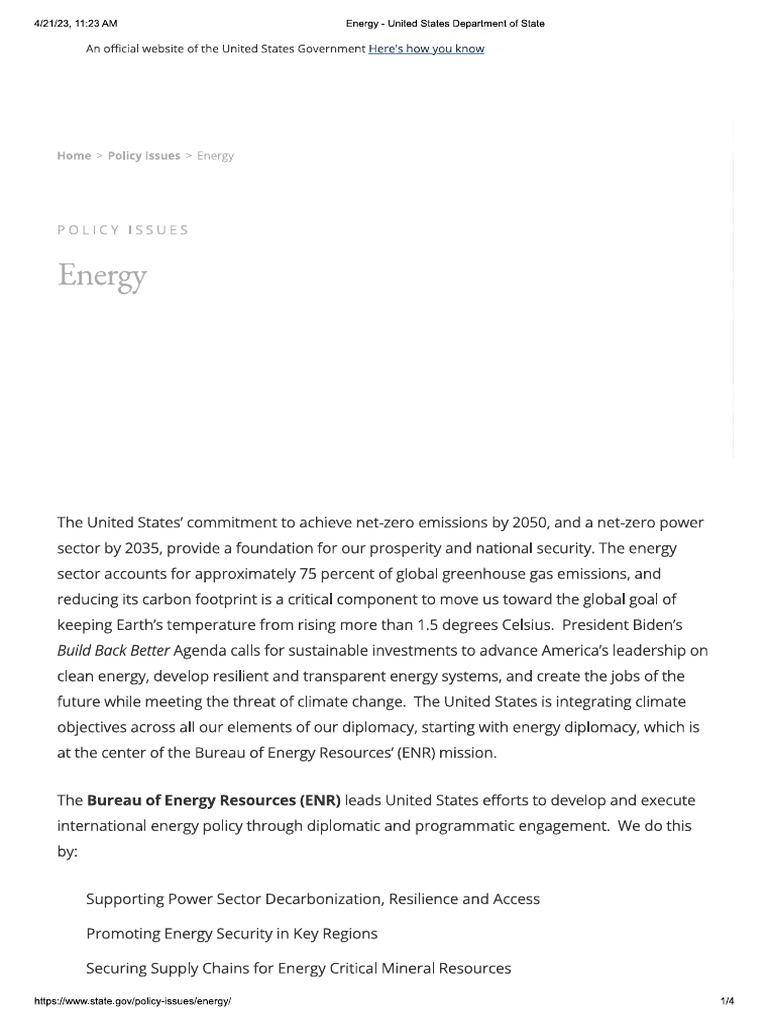The existence of the U.S. Department of Energy (DOE) has been a matter of considerable debate among policymakers, academics, and the general public. Established in 1977, the DOE is ostensibly tasked with both the advancement of energy technology and the management of the nation’s nuclear infrastructure. This discussion will explore various facets of the DOE’s purpose, operational efficacy, and relevance in the contemporary context of energy consumption, renewable resources, national security, and scientific innovation.
To commence, it is paramount to delineate the primary functions of the DOE. The Department’s responsibilities encompass a broad spectrum of energy-related activities, including research and development, the regulation of nuclear materials, and the promotion of energy conservation. One could argue that the DOE acts as a pivotal agency in addressing both the exigencies of energy generation and the imperatives of energy security.
In exploring whether the DOE should exist, one must consider its role in the evolving energy landscape. Traditional energy sources, particularly fossil fuels, have come under scrutiny due to their contributions to climate change and environmental degradation. In this context, the DOE has positioned itself as a catalyst for transition toward renewable energy sources. Programs focused on solar, wind, and geothermal energy are emblematic of the DOE’s commitment to fostering sustainable energy technologies. Their investment in research endeavors, such as solar panel efficiency and battery storage innovations, underscores an unmistakable initiative toward mitigating climate impacts.
Moreover, the DOE plays an instrumental role in the realm of national security through its oversight of the nuclear stockpile, management of nuclear waste, and regulatory framework governing nuclear power plants. The dual-use nature of nuclear knowledge, encompassing both energy generation and weaponization, necessitates a robust federal oversight mechanism that ensures safety and compliance with international treaties. By maintaining a central repository of nuclear knowledge and resources, the DOE not only safeguards national security interests but also engenders public confidence in nuclear energy as a viable alternative to fossil fuels.
Equally critical is the Department’s involvement in enhancing energy independence for the United States. The access to diverse energy sources promotes resilience against global fluctuations in energy markets. In recent years, the DOE has championed initiatives aimed at enhancing domestic energy production while simultaneously reducing reliance on foreign oil imports. This embraces the broader geopolitical implications of energy dependence, wherein a more self-sufficient energy landscape augments national sovereignty and stability.
Despite these merits, detractors of the DOE argue that its existence may exacerbate inefficiencies and bureaucratic overreach. One viewpoint contends that the private sector, driven by market dynamics, is sufficiently capable of pursuing energy advancements without the interference of a federal body. This libertarian perspective posits that government involvement can stifle innovation, impose unwarranted regulations, and lead to misallocation of research funding. Proponents of this view assert that a laissez-faire approach to energy development would yield superior outcomes through competitive forces.
Another significant facet of this debate pertains to the fiscal responsibilities and accountability of the DOE. As taxpayers fund government agencies, the question of whether the funding allocated to the DOE results in a commensurate return on investment arises. Critics highlight the need for transparent metrics to assess the Department’s effectiveness in meeting its objectives. Moreover, the potential for politicization of funding decisions can hinder the impartial advancement of scientific research, creating an environment that values short-term political gains over sustainable energy solutions.
Yet, the ideological dichotomy surrounding the DOE’s existence obscures some of the broader benefits it presents. For instance, the Department acts as a vital conduit for public-private partnerships, mobilizing resources and expertise across sectors. Initiatives such as the SunShot Initiative seek to leverage both public funding and private investment to propel solar energy technologies into mainstream acceptance. These collaborations may harness the best attributes of both sectors, advancing innovative technologies while distributing risks more equitably.
Moreover, the responsive nature of the DOE to scientific advancements and public policy changes cannot be overlooked. As the energy landscape evolves, so too does the need for a dedicated body that can pivot based on technological and societal shifts. The growth of electric vehicles necessitates infrastructure investment and regulatory frameworks that the DOE is well-placed to offer. Similarly, contamination clean-up challenges related to legacy nuclear sites demand sustained attention—a role ideally suited for a federal agency with the requisite expertise and authority.
In summary, the discourse surrounding the existence of the U.S. Department of Energy is multifaceted, marked by varied perspectives and implications. While the agency is burdened by bureaucratic challenges and criticisms about its efficiency, it is also a critical actor in navigating the complexities of energy security, technological advancement, and environmental stewardship. As society confronts pressing concerns regarding climate change and energy sustainability, the question may not necessarily hinge on whether the DOE should exist but rather on how it can evolve and adapt to better serve the nation in this transformative epoch.
Continued discourse is essential to determine the optimal balance between federal oversight and private sector innovation in the energy arena. Reflecting on the Department’s role encourages a nuanced understanding of the intersection between federal policy and transformative energy technologies—an understanding that will significantly influence the trajectory of America’s energy future.












